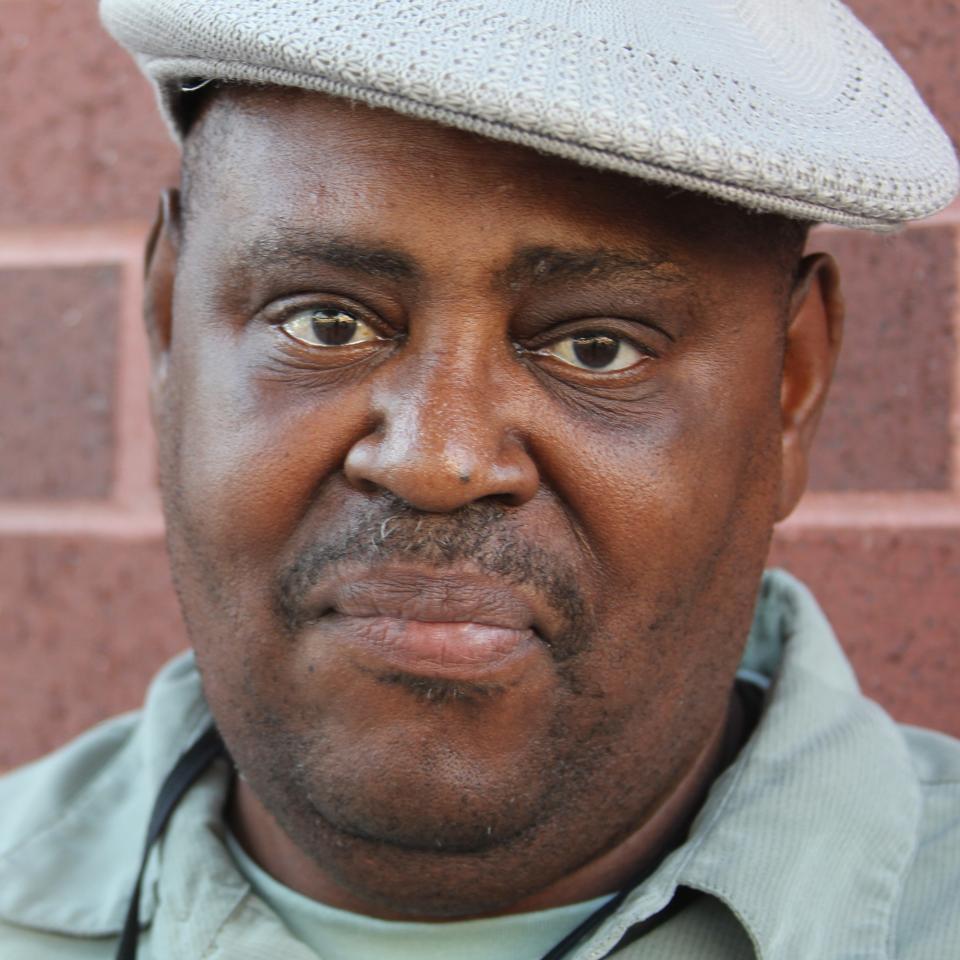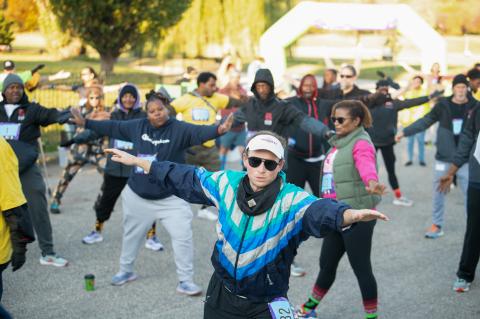
Client story: James Barnes
Superstar
On Sunday, May 21, James Barnes took the day off from work at Oriole Park at Camden Yards to sit in the stands and be a fan. Until the end of the fifth inning, that is, when he appeared on the Jumbotron and was honored by the Orioles organization and his thousands of fellow fans as a Birdland Community Hero. Amidst it all, his phone rang and his brother, who had just turned the game on at home in Harford County, told him, “You’re a superstar.”
To know James is to know that the comment from his brother means so much more than being on TV. The day and the honor mark the latest in a series of recent milestones for James. His journey from sickness and homelessness to health and stability has been a long one. But it’s been steady. And throughout, his optimism and determination to keep moving forward have never wavered. As James always likes to say, “I never gave up.”
###
A stubborn streak
James Barnes has always been determined. Stubborn, actually.
He was 5 years old when his little sister, Tabitha, was born. His mother was giving birth in the hospital maternity ward while he was downstairs in pediatrics, getting his tonsils out. He crept out of bed, found the maternity ward and nursery window and was jumping, trying to peer in, when his family found him. He refused to budge until they lifted him up to see the new baby. Then he went back to his room happily, without a fight.
That early stubborn streak stuck. And as much as it got him into trouble over the years, it has been a guiding force for James and it has saved him. It helped him survive a long prison stint and, once he was out, overcome years of chronic health problems, unemployment and homelessness.
Today, James’ diabetes is under control, he is working, he’s housed and he’s transitioning out of care at Health Care for the Homeless.
Next up on James’ list: To have his own place—and a dog.
###
Lost in the middle
James grew up in Havre de Grace in Harford County, Maryland, with his mother, grandmother and four siblings—two older brothers, a younger brother and baby Tabitha. His family was close—James grew up surrounded by aunts, uncles and cousins. “We didn’t have the best of things,” he says. “But we were happy.”
As the middle child, James longed for attention. He was the baby of the family for only a year and a half before his younger brother was born. Whenever the young family appeared in public together, all eyes would quickly turn to the baby, leaving James feeling ignored. It was the same at home—“It was always ‘Baby brother this’ and ‘Baby brother that,’” he says.
In school, James kept busy with the baseball, football and swim teams, and he learned to get the attention he lacked at home from his friends and teachers—usually by acting out. He recalls the time he got caught in the girls’ bathroom after his friends dared him to go in.
He first started getting into trouble with the law when he was in middle school. James and his friends stole bike parts—mirrors, lights, reflectors and the like. It was all about having the best bike and earning bragging rights among friends. One of his friends got stopped by the police because the seat on his bike resembled a stolen seat. It wasn’t the seat the police were looking for, but the friend was taken in for questioning, followed by James—and probation for both of them at the young age of 12.
“I guess not getting that attention, it just carried over into the teenage years,” James says. “And that’s when I would act out in school. It seemed like every time something would happen, me being a bully or something, I’d always get attention. And every time the police came to my house, it was, ‘Aw, what did James do now?’ Going through [those] teenage years, I was just misunderstood.” But as he grew older,
James says the desire for attention played out more as anger. “Once I realized it, it was too late—I was locked up.”
###
Prison
James spent his young adult years in and out of prison for theft and assault, the longest stint being an attempted murder charge when he was 29. A friend of his was assaulted by a guy with a knife and James jumped into to defend his friend. He took the man’s knife and beat him up, and when the man saw James some days later, he threatened him. James pulled out the knife he had taken from the man days earlier, and stabbed him. The man survived, but James went to prison on a 30-year sentence.
James had a number of experiences in prison that gave him clarity about his own life and what he wanted for his future. Coupled with that stubborn streak, these experiences cemented his resolve: to get out of prison, and to lead a good and healthy life.
James worked in the prison kitchen, washing dishes and helping clean the kitchen after church events, and ended up joining the prison church. At first, he agreed to join just to have something to do, but he slowly got more involved, eventually becoming an usher.
In prison, James saw people die regularly—not of violence, but of old age. One man, Mr. Ike, had been incarcerated for nearly 40 years. He was a fixture: He was there while other people arrived, served their time, left…and came back. Everyone liked Mr. Ike, James says, and everyone looked out for him. He died in his sleep at 57 years old, still in prison. Even the guards mourned him.
This, James says, is what motivates him to stay out of prison today. Mr. Ike was 57 when he died, and James’ own mother passed at 54. James is now 53 and has 9 years left on his current sentence. “I’m on parole right now,” he explains. “If I violate, that means I have to finish off my old sentence before I start my new one. I don’t want to die in there.”
###
A new—tough—start
James was released on parole on February 23, 2013. He had served 19 years of his 30-year sentence.
He went home to Harford County—with nothing, nowhere to go and no idea what to do. All of his family members had families of their own to care for now, and no one could take him in long-term. He had hoped to get his Class A driver’s license and land a commercial driving job, but his parole status got in the way: He has to stay local. He had hypertension, high cholesterol and diabetes and left prison with only a 30-day supply of insulin, which he quickly exhausted. “I was released and it was up to me to figure out where to go,” he says.
James convinced his parole officer to let him move to Baltimore, where he’d heard more supports were available for people rejoining the community after incarceration. He arrived in Baltimore in May, and began staying in the city’s main homeless shelter just down the street from Health Care for the Homeless, known as Code Blue. “I think that was what really got me started,” he says. He didn’t know anyone in the shelter, so he kept his head down at first. But he started to notice a few people who were doing the same thing, and he got to know them. And he began running into people he had known in prison. “They started showing me different programs and places to go. And Health Care for the Homeless was one of them. I started getting care at the Health Care for the Homeless mobile van at Code Blue.”
In September, James got kicked out of Code Blue for getting into a fight and began sleeping on the porch of Health Care for the Homeless. He then moved into another shelter, but again, got kicked out for throwing a TV (one of his housemates was messing with his football game watching) and he returned to the porch at Health Care for the Homeless—where he slept, received medical care, started going to anger management group twice a week and became active in client advocacy. With the help of his team of Health Care for the Homeless providers, he secured a slot in a transitional group house in Park Heights in January 2015.
A year later, James moved into Harbor City Residential House, where he shares a unit with three other men—and got a job. He worked briefly at Food Depot, manning the seafood counter, until baseball season started and he began selling concessions fulltime in the stands at Oriole Park at Camden Yards.
“All my pay is on commission and tips. It ain’t much—a dollar here and a dollar there—but the only thing really keeping me going is my tax return.”
He works three- to four-hour shifts at home games, always selling popcorn. “My favorite thing is seeing the little kids. They’re my biggest supporters. They eat a lot of popcorn. And at Oriole Park I’m not getting angry. I’m not getting frustrated at anybody.”
###
Still working
“From the age of 20 up to now, I’ve been in and out of prison. You figure that out of my adult life, from age 20 to 50, I’ve spent 27 years in prison,” James says. “There’s a lot of times when I’m cleaning up around the house and I think about what would have happened if I had stayed in Harford County and not come to Baltimore and started doing things that changed my life—taking that first step as far as rebuilding my life…”
Where he is in his life right now—“It’s not where I want to be,” James says. “But it’s me working toward that.”
And his work is constant—and far reaching. “I’m always talking to the young adults in Harbor City’s other houses. I call them my young adults, not Harbor City’s. I try to set an example. They’re not babies, not teenagers, but young adults. And they like it when I sit down and talk to them like that. I try to be a mediator between the staff and the young adults.”
James also is actively involved in advocacy at Health Care for the Homeless, and travels out to the agency’s Baltimore County clinic one Friday to support a smaller, emerging client advocacy effort there. This past May he was honored for his contributions to the Health Care for the Homeless and greater Baltimore communities by his employer, the Orioles. And in June, at the recommendation of Health Care for the Homeless peers and staff, he was appointed to the Health Care for the Homeless Board of Directors.
More Recent News
At our annual staff holiday party, we take time to recognize and celebrate staff members who best represent our Core Values, as well as one recipient of the Von Bradshaw Award, named after Delvonia "Von" Bradshaw, who passed away in 2024 and truly held the principles of Health Care for the Homeless to heart. Please congratulate your colleagues when you see them!
Those of us in the Health Care for the Homeless community share a belief in something powerful: that everyone should have a place to call home.
Hope for that vision isn’t passive. It’s something that clients, staff and community supporters make possible together.
With SNAP benefits in Maryland facing uncertainty, many families are wondering how they’ll put food on the table. Here are ways Health Care for the Homeless is helping, as well as a list of local food assistance resources.
On Saturday, November 1, more than 300 runners, walkers, friends and volunteers gathered in Patterson Park for the 2025 Rock Your Socks 5K. Read all about this year's awesome event!




